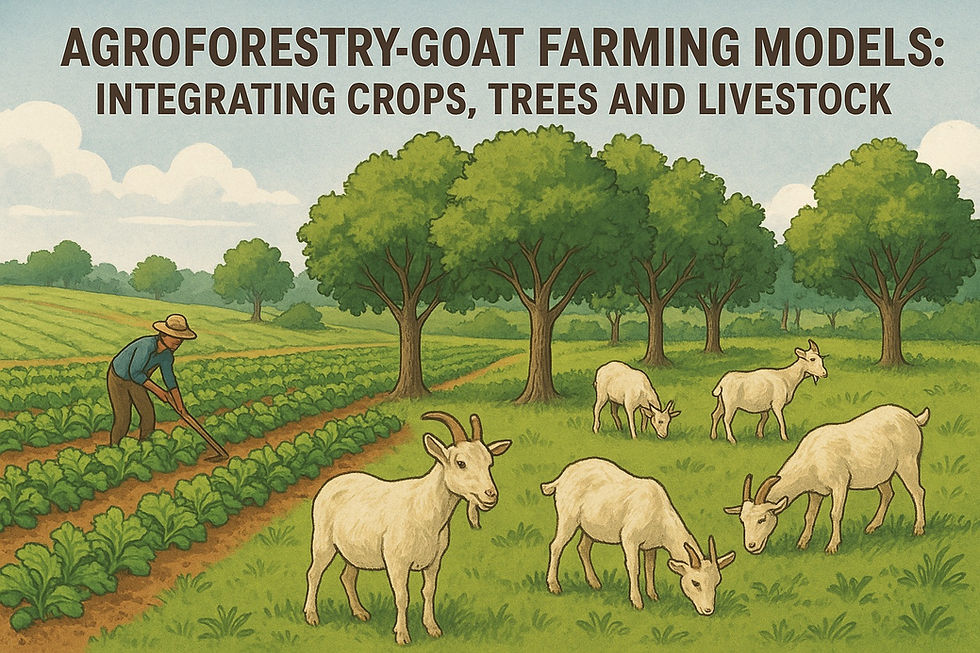Coastal Climate and Goat Farming: Adapting Practices for Success
- Global Services TGT
- Jun 20
- 3 min read
India’s vast coastline stretches over 7,500 kilometers, encompassing diverse ecosystems and communities that rely heavily on agriculture and livestock for their overall livelihoods. Goat farming, in particular, has shown great promise as a sustainable and profitable activity along the coast. However, the unique challenges posed by the coastal climate require farmers to adapt improved management and husbandry practices to ensure healthy, productive herds.
This article explores the impacts of coastal climate on goat farming and offers practical tips for adaptation that can help farmers thrive in these regions.
Understanding the Coastal Climate: Coastal areas in India typically experience:
High humidity and salinity
Moderate to high temperatures year-round
Heavy monsoon rains
Occasional cyclones and strong winds
Sandy or saline-prone soils
These factors influence forage availability, disease risks, and shelter needs for goats, demanding customized strategies for effective farming.
Challenges for Goat Farming in Coastal Regions:
Humidity and Disease Pressure: High humidity fosters parasites, fungal infections, and respiratory diseases in goats. Wet conditions increase the risk of foot rot and other bacterial infections.
Saline Soil and Forage Scarcity: Salinity reduces the growth of traditional pasture plants, making quality forage scarce during certain seasons.
Weather Extremes: Cyclones and heavy rains can damage shelters, wash away feed, and increase stress among animals.
Adapting Goat Farming Practices for Coastal Success:
Shelter and Housing
Build raised, well-ventilated shelters with sloped roofs for efficient rainwater drainage.
Use locally available, durable materials like bamboo, coconut palm leaves, and treated wood to withstand humid conditions.
Position shelters away from salty waterlogging areas to prevent structural damage and health risks.
Feeding and Nutrition
Introduce salt-tolerant forage species like Atriplex, Suaeda, and other halophytes which thrive in saline soils.
Supplement with concentrated feed and mineral mixtures, especially to counteract deficiencies caused by saline environments.
Promote fodder cultivation in raised beds or controlled environments to ensure a steady supply during monsoon or drought.
Health Management
Implement regular deworming and vaccination schedules to combat parasitic infestations and prevent common diseases.
Practice foot care and hygiene to reduce foot rot and other infections aggravated by high moisture conditions.
Monitor goats closely for signs of respiratory or fungal infections common in humid climates.
Breeding and Stock Selection
Choose or develop breeds and strains adapted to humid and saline environments, like the Osmanabadi or Black Bengal goats.
Avoid introducing exotic breeds that may be susceptible to local climate stressors.
Practice controlled breeding to enhance traits like disease resistance and heat tolerance.
Economic and Social Benefits: Adopting these adaptive practices can:
Improve goat survival rates and productivity
Provide a steady income source for coastal farmers and fisherfolk communities
Reduce dependence on imported feed or veterinary inputs
Enhance resilience against climate variability and natural disasters
In Kerala’s coastal districts, farmers have successfully integrated goat farming with coconut and rice cultivation. By using raised platforms for shelter and planting salt-tolerant fodder along canals, they have increased kid survival rates by over 30% and boosted milk and meat production—all while protecting their livelihoods from coastal climate challenges.
Goat farming in coastal India holds significant potential, but only if farmers embrace climate-smart, locally adapted, improved management practices. By understanding the unique demands of the coastal environment and tailoring housing, nutrition, health, and breeding accordingly, coastal farmers can achieve sustainable success and improve their resilience against environmental challenges.



Comments